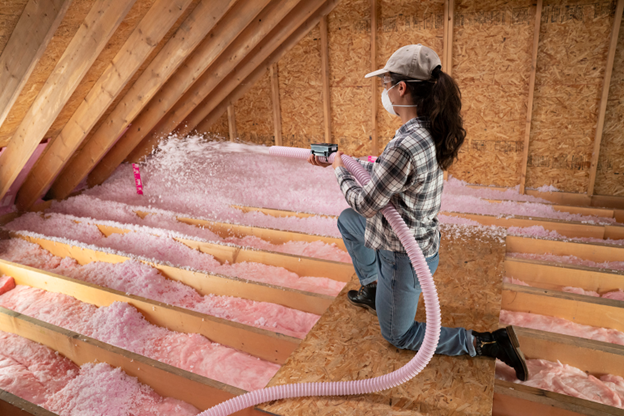Energy bills climbing higher each month? Cold drafts sneaking through your walls despite cranked-up heating? Your home’s insulation might be the culprit. While traditional batt insulation has dominated residential construction for decades, a growing number of homeowners are discovering the superior performance of blown-in insulation.
This shift isn’t just a trend—it’s a response to rising energy costs and the need for more effective thermal barriers. Blown-in insulation offers solutions that traditional methods simply can’t match, filling every nook and cranny that contributes to energy loss.
What Makes Blown-In Insulation Different
Blown-in insulation consists of loose-fill materials that get installed using specialized equipment. Rather than cutting pre-formed batts to fit between studs, contractors use a blowing machine to distribute the insulation material into wall cavities, attics, and other spaces.
The most common materials include cellulose (made from recycled paper), fiberglass, and mineral wool. Each material gets processed into small pieces that can flow through hoses and settle into tight spaces that sheet insulation can’t reach.
This installation method creates a seamless thermal barrier. Unlike batt insulation, which often leaves gaps around electrical outlets, pipes, and irregular framing, blown-in insulation conforms to every surface and obstacle.
The Performance Advantage
Traditional insulation methods struggle with consistency. Even professional installations often result in compressed areas, gaps, and thermal bridges that reduce overall effectiveness. Blown-in insulation eliminates these common problems through its installation process.
The loose-fill material settles uniformly, creating consistent density throughout the installation area. This uniformity translates to predictable thermal performance and eliminates the hot and cold spots that plague many homes with traditional insulation.
Moisture management represents another significant advantage. Many blown-in materials naturally resist moisture absorption and allow vapor transmission, reducing the risk of mold growth and structural damage from trapped humidity.
Cost Considerations That Matter
Installation costs for blown-in insulation typically run higher than DIY batt installation but often cost less than professional batt installation. The specialized equipment requires professional handling, but the faster installation process can offset labor costs.
Long-term savings often justify the initial investment. Homeowners frequently report 10-30% reductions in heating and cooling costs after upgrading to blown-in insulation. These savings compound over time, making the insulation pay for itself through reduced energy bills.
The durability factor also affects long-term costs. Quality blown-in insulation maintains its performance for decades without settling or degrading significantly. This longevity means fewer replacements and maintenance costs compared to other insulation types.
Installation Realities
Professional installation is virtually mandatory for blown-in insulation. The equipment costs thousands of dollars and requires expertise to operate safely and effectively. Attempting DIY installation often results in uneven coverage and wasted material.
The installation process itself is relatively quick, but can be messy. Contractors typically complete most residential jobs in a single day, but preparation and cleanup add time to the overall project timeline.
Access requirements vary depending on the installation location. Attic installations are straightforward, while wall installations may require drilling holes that need patching and painting afterward.
Environmental Impact
Cellulose blown-in insulation contains up to 85% recycled content, primarily from post-consumer paper products. This high recycled content gives it strong environmental credentials compared to fiberglass, which requires significant energy to manufacture.
The manufacturing process for blown-in materials typically uses less energy than traditional insulation production. Combined with the longer lifespan and better performance, the environmental benefits extend beyond just recycled content.
Energy savings from improved insulation performance also contribute to environmental benefits. Reduced heating and cooling demands mean lower carbon emissions from power plants and natural gas consumption.
Common Misconceptions
Many homeowners worry about blown-in insulation settling over time and losing effectiveness. While some settling occurs, quality materials and proper installation minimize this effect. Modern blown-in insulation maintains most of its original thickness and thermal performance for decades.
Concerns about pest problems also surface frequently. Properly treated cellulose insulation deters insects and rodents through added fire retardants that these pests find unpalatable.
Some people assume blown-in insulation creates dust problems or poor indoor air quality. Professional installation includes sealing work that often improves air quality by reducing infiltration of outdoor pollutants and allergens.
Making the Right Choice for Your Home
Blown-in insulation works best in specific situations. Homes with irregular framing, numerous penetrations, or hard-to-reach areas benefit most from the conforming properties of loose-fill materials.
The age of construction plays a role in decision-making. Older homes often have unique framing and settling that create gaps in traditional insulation. Blown-in insulation adapts to these irregularities better than rigid alternatives.
Climate considerations matter too. Homes in extreme climates see the greatest energy savings from high-performance insulation, making the investment more attractive in these regions.
Future-Proofing Your Investment
Building codes continue evolving toward higher insulation requirements. Blown-in insulation makes it easier to meet future efficiency standards without major renovations. The ability to add material over existing insulation provides upgrade flexibility that traditional methods can’t match.
Smart home technology integration also favors high-performance insulation. Advanced HVAC systems work more efficiently when paired with consistent thermal barriers, maximizing the benefits of both investments.
The Bottom Line on Blown-In Insulation
Blown in Insulation represents a significant improvement over traditional methods by offering superior coverage, consistent performance, and long-term durability that justify higher upfront costs through energy savings and enhanced comfort.
Success depends largely on proper installation and material selection. Working with experienced contractors who understand local climate conditions and building requirements ensures optimal results and maximum return on investment.
Consider blown-in insulation when renovating, building new construction, or addressing comfort and energy efficiency problems. The technology has matured to the point where it offers clear advantages for most residential applications.

